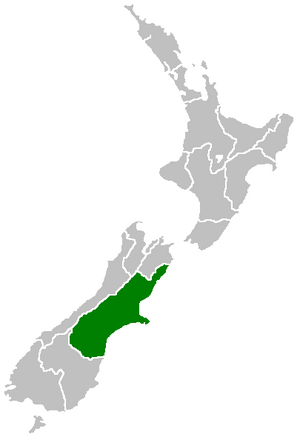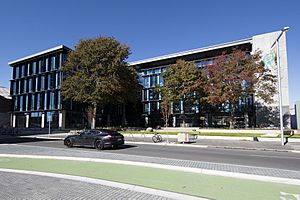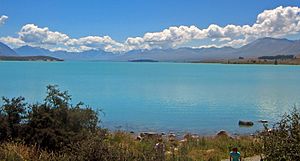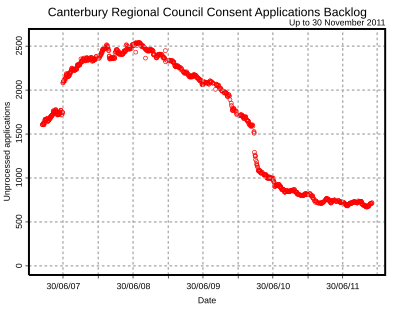Environment Canterbury facts for kids
| Regional council | |

Logo of Environment Canterbury
|
|
| Formation | 1989 |
|---|---|
| Region | Canterbury |
| Country | |
| Website | http://www.ecan.govt.nz |
| Leadership | |
| Chair | Peter Scott |
| Deputy Chair | Craig Pauling |
| Headquarters | 200 Tuam Street, Christchurch |
Environment Canterbury, often called ECan, is the official name for the Canterbury Regional Council. It is the main local government body for Canterbury, which is the largest region in the South Island of New Zealand. ECan plays a big part in how the Canterbury region is managed and looked after.
Contents
What Environment Canterbury Does
ECan is in charge of a large area. This includes all the river systems on the east coast of the South Island. It stretches from the Clarence River near Kaikōura down to the Waitaki River in South Canterbury. This huge area also covers the Canterbury Plains and major rivers like the Waimakariri River.
ECan has many important jobs. These include managing public transport, controlling pests and diseases (biosecurity), and looking after rivers. They also check the environment, create regional plans, and approve permits for using land and water. ECan's main focus areas are air, water, and transport.
Christchurch sometimes has air quality problems. This happens when cool air traps pollution close to the ground. To help with this, ECan started the Clean Heat Project in 2002. It ran until 2011 and helped people get cleaner home heating and better home insulation.
A Look at ECan's History
The Canterbury Regional Council was first formed in 1989. This happened after big changes were made to local government across New Zealand. Before that, there was a group called the Canterbury United Council, which was the first regional government in the area since 1876.
Where ECan Works From
Environment Canterbury's main office is in Christchurch at 200 Tuam Street. This building was specially designed to be good for the environment. About 500 staff members work there. The old building was damaged in the Canterbury earthquakes and was taken down in 2011. Staff moved into the new building in April 2016. ECan also has smaller offices in other towns like Timaru, Ashburton, and Kaikōura.
How ECan is Governed
From 1989 until 2010, the Canterbury Regional Council was led by 14 elected councillors. These councillors were chosen by people voting in different areas of the region.
Changes in Leadership (2010–2019)
In 2010, the New Zealand Government decided to replace the elected councillors with a group of special leaders called commissioners. This decision was made after a report suggested there were delays in approving important permits. The commissioners were in charge until the local elections in October 2016.
For the 2016 elections, a new system was put in place. Seven members were elected by the public, and six others were appointed (chosen) by the Government. This mixed group led ECan until 2019. After 2019, the council returned to being fully elected by the public.
Current Council Members (2022–Present)
The council members are elected by the public from different areas (constituencies) within Canterbury. Here are the members from the 2022 local elections:
| Name | Affiliation (if any) | Regional constituency |
|---|---|---|
| Grant Edge | Independent | North Canterbury/Ōpukepuke |
| Claire McKay | Independent | North Canterbury/Ōpukepuke |
| Greg Byrnes | Independent | Christchurch Central/Ōhoko |
| Genevieve Robinson | Independent | Christchurch Central/Ōhoko |
| Joe Davies | The People's Choice – Labour | Christchurch North East/Ōrei |
| David East | Independent | Christchurch North East/Ōrei |
| Paul Dietsche | Get Things Done | Christchurch South/Ōwhanga |
| Vicky Southworth | Independent | Christchurch South/Ōwhanga |
| Craig Pauling | The People's Choice | Christchurch West/Ōpuna |
| Deon Swiggs | Independent | Christchurch West/Ōpuna |
| Ian Mackenzie | Independent | Mid Canterbury/Ōpākihi |
| John Sunckell | Independent | Mid Canterbury/Ōpākihi |
| Peter Scott | Independent | South Canterbury/Ōtuhituhi |
| Nick Ward | Independent | South Canterbury/Ōtuhituhi |
On May 3, 2024, Peter Scott stepped down as ECan's chair. This happened after an investigation into his farm activities. Craig Pauling then became the acting-chair.
Chief Executive
The Chief Executive is like the head manager of ECan. Stefanie Rixecker became the Chief Executive in August 2020. She took over from Bill Bayfield, who had been in the role since 2011.
Regional Parks ECan Manages
ECan also looks after four special regional parks. These parks are places where people can enjoy nature and outdoor activities.
- Ashley Rakahuri Regional Park
- Northern Pegasus Bay
- Lake Tekapo Regional Park
- Waimakariri River Regional Park
Regional Plans and Water Rules
ECan creates important plans to manage the environment in Canterbury. The main plan is called the Natural Resources Regional Plan (NRRP). This plan sets out rules for things like air quality, water quality, and how much water can be used. It also covers how to protect wetlands and soil.
There are also special rules called Water Conservation Orders (WCOs) for some rivers and lakes. These orders help protect the natural state of important waterways like the Rakaia River and Lake Ellesmere.
Resource Consents and Permits
ECan is responsible for giving out and checking the most resource consents in New Zealand. A resource consent is like a permit that allows people to do things that might affect the environment, such as taking water from a river or discharging waste.
For example, in the year ending June 2006, ECan handled over 3,300 applications for these permits. This was more than double any other regional council in New Zealand. You can often view the details of these permits online using a special "CRC" number.
Sometimes, ECan has a lot of applications to process, which can cause a "backlog." This means there's a delay in approving permits. This happened in 2004, partly because many people applied to take groundwater. ECan's website shows how many applications are waiting to be processed each day.





